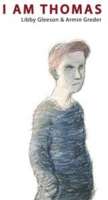
I Am Thomas
Written by Libby Gleeson, illustrated by Armin Greder
Allen & Unwin, 2011, N. P.
ISBN: 978-1742373331
With minimal text and vexing images, I am Thomas begins as readers are introduced to Thomas through several pages of illustrations consisting of white background with scattered toys and items reminiscent of his childhood. These items are depicted in color with the simple words, “I am not the child I once was.” As the pages progress, we join Thomas on his life’s journey as he remembers the voices around him giving orders and saying “do as we say, think like us, be like us.” The images of the individuals—parents, teachers, religious leaders, and political leaders—are created in sketches of black and white and reflect their disappointment, disdain, and anger at Thomas’s failure to conform to their standards and way of life. The black and white images indicate events of the past and also set the tone for the memories as perceived by Thomas that constitute the majority of this story. In some cases the faces in the illustrations that reflect the voices in his mind are almost grotesque, especially in pictures showing the religious figures or the political ones calling for young men to join the army or asking for votes. Thomas’s thoughts are printed in normal font size text while the angry words he is remembering are in large bold print. Occasionally, these words are repeated in gray creating an echo effect that one can imagine reflects what Thomas is replaying in his mind. Even as Thomas responds, saying he is not the child his brother is and not the student others are, he is met with words that imply he is headed for failure. Ultimately, he becomes more withdrawn.
The images on the white pages return to color as Thomas reappears on the page as a young man with the final text that says, “But Thomas would not.” And, the following pages tell the rest of the story in images as Thomas picks up a small yellow bus from among his toys and with a faraway look on his face invites readers to turn the page and watch Thomas boarding a bus with his backpack, ready to continue his life’s journey on his own.
One can only think of the despair of adolescents who never fit in and are consistently told to conform—how to be, how to act—by those surrounding them as they grow up. The message here is universal and yet as uniquely specific as those youth whose interests and resources are seldom tapped in school and in their communities because of their perceived failure to conform. The story serves as a message of courage that is often needed for individuals to resist oppression and pursue their paths and interests in life. Other books that carry this theme as well are Jose, Born to Dance (Susanna Reich, 2005) and The Dreamer (Pam Munoz Ryan, 2010).
Libby Gleeson and Armin Greder have collaborated on other books: The Great Bear (1999) and An Ordinary Day (2001). They won the Bologna Ragazzi Awarded in 2000 for The Great Bear. This was the first time an Australian book won this award. Libby Gleeson has published over 30 books for children and teens and has won the Children’s Book Council for Australia award three times. Armin Greder migrated to Australia in 1971 from Switzerland and taught graphic design and illustration. He illustrated The City (2010) and The Island (2008), reviewed in this column, and has been nominated for numerous significant awards, including the Hans Christian Andersen Award. The awards bestowed on this author and illustrator attest to the high regard held for this international team and their ability to create a book with universal emotional appeal and significance.
Janelle Mathis, University of North Texas, Denton, TX
WOW Review, Volume IV, Issue 2 by Worlds of Words is licensed under a Creative Commons Attribution-NonCommercial-ShareAlike 4.0 International License. Based on work at https://wowlit.org/on-line-publications/review/iv-2/

I hadn’t read this review before; thank you so much for appreciating the essence of Jacob’s story.
Thank you. We’re glad you found it! Our goal with WOW Review is to make global literature more visible so we are thrilled it “worked” and you found the review insightful.
Susan Corapi & Prisca Martens, Co-Editors, WOW Review